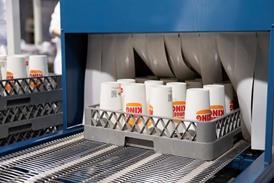
The world’s biggest brands are changing how they package their products. Ton Knipscheer of the European Co-Packers Association and TK Consulting tells us more about the drivers of this trend, and how we can expect it to evolve in the future.
Let’s start with an introduction – please could you tell us a bit more about yourself and your professional background?
I believe it’s not an understatement to say that I literally grew up in packaging, as my parents ran several packaging companies. I started my packaging career with the Weidenhammer Packaging Group, where I ran their Dutch site, was responsible for the Pringles account and worked in their UK site in Bradford, preparing the site for the acquisition by Sonoco.
I’ve been an independent packaging consultant now for almost 10 years. One of my roles is being on the board of the European Co-Packers Association, ECPA, where I also serve as Executive Director.
I’d like to talk to you today about an area that is of particular interest to both you and our readers: brand owners. You argue that the way these companies conduct their business in the packaging space is changing, due to shifts in global supply chains. Could you tell us more about this?
We’re seeing a fundamental shift in how brand owners manage their supply chains. In the past, many CPGs relied on heavily on in-house production. Today, the reality is that global supply chain disruption, cost pressures and consumer demand for agility have changed the equation.
Brand owners increasingly rely on specialized co-packers/manufacturers to provide the speed, flexibility and innovation markets (i.e. retailers & consumers) are expecting. This trend is particularly visible in FMCG, where responsiveness is everything.
By working with co-packers, brand owners can scale production quickly, adapt to market trends and reduce risk (and Capex!), while still protecting their core brand identity.
A growing number of brands now manufacture nothing themselves, preferring instead to focus on their core competencies. What effect does outsourcing every production step like this have on brands?
Without calling names, more and more high street brands, including some really renowned global cosmetic ones are focusing on what they do best: building a brand, marketing it to the consumers and then expanding it. Outsourcing production enables them to concentrate on consumer insight and product innovation, without the hassle of having to manage machines and international supply lines.
Done well, this model can deliver enormous benefits; lower capital costs, greater agility and shorter time-to-market. But it requires a mindset shift; brand owners must see co-packers as strategic allies, not just suppliers.
Looking ahead to the future now, which capabilities will brand owners definitely need to retain in-house, and which are better left to specialized co-packers?
If building and expanding brands and marketing these to the consumer are what brand owners do best, it is critical that these core activities need to be retained in-house. These are central to differentiation and long-term competitiveness.
However, when it comes to operational execution, particularly production, packaging, filling and secondary operations, co-packers are often better placed.
They offer specialized expertise, scale and flexibility that is not so evident for the brand owners to replicate. As the legislative pressure is also increasing, including a growing number of sustainability directives, such as PPWR, EPR, EUDR etc., co-packers with their network of shared infrastructure and innovation, are better placed to deal with these growing challenges. The winning formula will be a clear division of roles: brands focusing on vision and strategy, co-packers on flawless and sustainable delivery.
We’ll be welcoming a host of brand owners to the 2025 Sustainable Packaging Summit later in the year. In light of our discussion today, what advice would you give them?
My advice is to view co-packers not simply as a flexible extension of your capacity, but as partners in innovation and sustainability. The packaging landscape is changing fast, with new regulations, shifting consumer expectations, and complex material choices.
No brand can navigate this alone. By collaborating with co-packers, you gain access to practical expertise, specialized equipment and a shared commitment to reducing environmental impact.
At the Summit, I would encourage brand owners to openly exchange ideas, build partnerships, and recognize that sustainability challenges are best solved collaboratively. The future belongs to those who combine strategic vision with agile, specialized execution.
The Sustainable Packaging Summit mobilizes leaders of the FMCG value chain, policymakers, NGOs, recyclers and investors to collaborate, remove barriers and identify opportunities on the road to sustainable transformation.
To learn more or register, visit: https://www.packagingsummit.earth/




















No comments yet